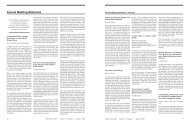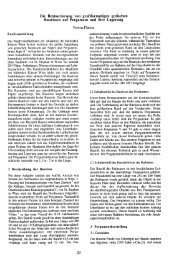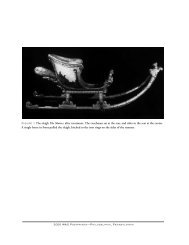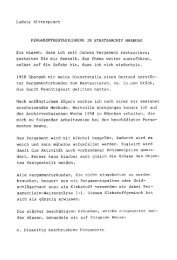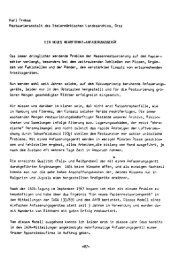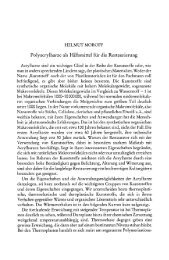The Development of a New Conservation Treatment for Ink ... - IADA
The Development of a New Conservation Treatment for Ink ... - IADA
The Development of a New Conservation Treatment for Ink ... - IADA
You also want an ePaper? Increase the reach of your titles
YUMPU automatically turns print PDFs into web optimized ePapers that Google loves.
<strong>The</strong> <strong>Development</strong> <strong>of</strong> a <strong>New</strong> <strong>Conservation</strong> <strong>Treatment</strong> <strong>for</strong> <strong>Ink</strong> Corrosion, Based on the<br />
Natural Anti-oxidant Phytate<br />
INTRODUCTION:<br />
CAUSES OE' INK CORROSION<br />
<strong>Ink</strong> corrosion, the degradation <strong>of</strong> the substrate caused by<br />
the corrosive action <strong>of</strong> irongall inks, is a difficult<br />
rcstorati~~e problem encountered with manuscripts and<br />
pen drawings made on paper or parchment. Different<br />
causes have been suggested <strong>for</strong> the degradative process.<br />
Irongall inks usually contain acid: pH values range<br />
fro~n 1.0 - 3.1'. Acid catalyses the hydrolysis <strong>of</strong><br />
cellulose in paper2. In general, deacidification slows<br />
down ink corrosion3. During accelerated ageing<br />
however, it failed to protect the paper against the<br />
recurrence <strong>of</strong> new acidity, as was shown by Hey4.<br />
<strong>The</strong>re<strong>for</strong>e, acidity can not be the only cause <strong>of</strong> ink<br />
corrosion. Simulating tests <strong>of</strong> ink corrosion by<br />
accelerated ageing <strong>of</strong> different types <strong>of</strong> paper treated<br />
with irongall ink showed that the lignin-free paper<br />
degraded faster than the lignin-containing paper, even in<br />
the presence <strong>of</strong> acid alum sizing in the latter 5'6. Lignin<br />
will act as an anti-oxidant because it is oxidised faster<br />
than cellulose and <strong>for</strong>ms stable radicals7. <strong>The</strong>re<strong>for</strong>e, this<br />
observation is indicative <strong>of</strong> the oxidative character <strong>of</strong><br />
the process.<br />
Figure 1. Russell image (above), <strong>for</strong>med by a piece <strong>of</strong> an<br />
18th-centus, manuscript (below) on a<br />
sensitised film (parts <strong>of</strong> the manuscript were<br />
used <strong>for</strong> other tests)<br />
Iron(I1) ions are suspected to cause the oxidative<br />
degradation <strong>of</strong> cellulose by catalysing the <strong>for</strong>mation <strong>of</strong><br />
hydroxyl radicals (HO.) from hydrogen peroxide in the<br />
so-called "Fenton reaction", as is shown be10w"~.<br />
~ e ~ + + H,O, ~ e + ~ HO* ' .+ OH-<br />
Hydrogen peroxide is <strong>for</strong>med during the reduction <strong>of</strong><br />
molecular oxygen by iron(I1) ions. Its <strong>for</strong>mation at the<br />
ink surface could be detected by the Russell test, shown<br />
J. G. Neevel<br />
in Figure 1. This test uses a sensitised black-and-white<br />
film (details given in the experimental secti~n)~"~.<br />
Hydroxyl radicals are very reactive and readily absuact<br />
hydrogen from cellulose, leading to the <strong>for</strong>mation <strong>of</strong><br />
organic radicals (Ra). <strong>The</strong>se react in a chain reaction<br />
with oxygen and a new cellulose molecule (R'H) to<br />
<strong>for</strong>m cellulose hydroperoxide (ROOH) and a new radical<br />
(R'.), as is shown below.<br />
R- + 0 2 ROO .<br />
ROO. + R'H ROOH + R'.<br />
Chain scission occurs when cellulose hydroperoxide<br />
reacts with iron(I1) ions in a Fenton-like fashion, as is<br />
shown in Figure 2.<br />
Fipre 2. Mechanisrn <strong>of</strong> the scission <strong>of</strong> the P-glycosidic<br />
bond in cellulose hydroperoxide<br />
Iron(I1) ions thus play a dominant role in the oxidation<br />
<strong>of</strong> cellulose. Most old irongall-ink recipes contain an<br />
excess <strong>of</strong> iron(I1) sulphate compared to the tannin<br />
content. According to an <strong>of</strong>ficial advertisement <strong>of</strong> the<br />
British government <strong>of</strong> 1889, a stable black irongall ink<br />
should not contain more than 3 parts <strong>of</strong> nutgalls to 1<br />
part <strong>of</strong> iron(I1) sulphateI1. Upon ageing, this ink does<br />
not turn brown. This ideal ratio was established earlier<br />
by Caneparius in 1660 and Lewis in 178712. Assuming<br />
a tannin content <strong>of</strong> 55% in the nutgalls, molecular<br />
weights <strong>of</strong> the tannin and iron(I1) sulphate to be<br />
respectively 1700 and 278, this ratio amounts to a<br />
weight ratio <strong>of</strong> 7.3:l <strong>for</strong> tannin to iron in the irongall<br />
ink. This ratio falls well within the range <strong>of</strong> ratios (7 -<br />
10: 1) calculated from the weight percentages <strong>of</strong> iron and<br />
tannin given by the Merck Index <strong>for</strong> iron(II1) tannate<br />
(70 - 80% tannin, 8 - 10% iron), thereby confming<br />
these results13. A survey <strong>of</strong> 104 historical ink recipes<br />
from the 15th to the 19th century showed that the<br />
majority (about 30%) contained 2 parts <strong>of</strong> nutgalls to 1<br />
Part <strong>of</strong> iron(I1) sulphate, which is equivalent to a<br />
molecular ratio <strong>of</strong> iron(1I) sulphate to tannin <strong>of</strong> 551.<br />
<strong>The</strong> mean ratio was calculated to be 1.6 parts to 114J5.<br />
<strong>The</strong>re<strong>for</strong>e, most <strong>of</strong> these recipes contain too much iron.<br />
Because <strong>of</strong> the presence <strong>of</strong> reducing substances in the
paper (e.g. oxalic acid), even after centuries the iron can<br />
still be present as iron(I1) ions that catalyse the<br />
oxidative degradation <strong>of</strong> cellulose, as discussed above.<br />
By Mössbauer-spectroscopic anaiysis an iron(I1) content<br />
<strong>of</strong> 45 - 48% <strong>of</strong> the total amount <strong>of</strong> iron was established<br />
by Darbour e.a. in a 15th-century manuscript inkI6.<br />
Own measurements with this technique, conducted at<br />
the Delft University <strong>of</strong> Technology, established an<br />
iron(I1) content <strong>of</strong> about 20% in an 18th-century<br />
manuscript ink. This manuscript was severely damaged<br />
by ink corrosion (see also Figure 1).<br />
Acid also stabilises iron(I1) ions by preventing them to<br />
be oxidised. <strong>The</strong> brown discolourations usually ob-<br />
served along the ink regions in paper artefacts damaged<br />
by ink corrosion, are indicative <strong>of</strong> the presence <strong>of</strong><br />
iron(I1) ions in the original ink. <strong>The</strong>se discolourations<br />
may have been caused by the diffusion <strong>of</strong> the iron(I1)<br />
ions out <strong>of</strong> the acid ink regions to less acid<br />
surroundings, where they were oxidised to less soluble<br />
iron(II1) hydroxides. In this way, deacidification slows<br />
down the oxidative degradation by diminishing the<br />
amount <strong>of</strong> iron(I1) ions through the oxidation to<br />
iron(II1) hydroxides. At too high pH-values however<br />
(pH > 10), the ink itself can be degraded by<br />
decomplexation and oxidation <strong>of</strong> the tannin to light-<br />
coloured productsI7.<br />
TREATMENT OF INK CORROSION<br />
(THEORY)<br />
A conservation treatment <strong>of</strong> paper artefacts threatened<br />
by ink corrosion should be based on the inhibition <strong>of</strong><br />
the acid hydrolysis and the iron(I1)-catalysed oxidation<br />
<strong>of</strong> cellulose. Attempts have been made to prevent the<br />
catalytic oxidation by complexing the iron(I1) ions with<br />
Ethylene Diamine Tetra Acetate (EDTA)~. <strong>The</strong>se were<br />
not succesful; on the contrary: the addition <strong>of</strong> EDTA<br />
accelerated the degradation process during artificial<br />
ageing. This phenomenum can be explained by the fact<br />
that EDTA also complexes iron(II1) ions, rendering<br />
them soluble. <strong>The</strong>y can then be reduced to iron(I1) ions.<br />
Moreover, it does not block the coordinating position<br />
<strong>for</strong> hydrogen peroxide at the iron(I1) ion, there<strong>for</strong>e it<br />
does not prevent the <strong>for</strong>mation <strong>of</strong> hydroxyl radicals by<br />
the Fenton reaction. On1 a few complexing agents<br />
1<br />
block the Fenton reaction r . One <strong>of</strong> them is phytic acid,<br />
a natural anti-oxidant present in seeds. Mixed calcium<br />
and magnesium salts <strong>of</strong> phytic acid (phytates), Store<br />
about 60 - 90% <strong>of</strong> the phosphor present in plant<br />
tissues. Cereals, nuts, legumes, Spores, oil seeds,<br />
needles and pollen contain up to 5% by weight <strong>of</strong> these<br />
phytates. Phytate has been demonstrated to block the<br />
iron-catalysed oxidation <strong>of</strong> unsaturated fatsl''*O. It seems<br />
very succesful in protecting seed lipids against<br />
oxidation, as some seeds germinated even after 4<br />
centuries <strong>of</strong> dry Storage. <strong>The</strong> structure <strong>of</strong> phytic acid in<br />
aqueous solution is shown in Figure 3. It is the<br />
completely phosphorylated ester <strong>of</strong> myo-inositol (myoinositol<br />
hexakisphosphate). Five <strong>of</strong> the phosphate<br />
groups are in an equatorial position relative to the<br />
cyclohexane skeleton, one is in an axial position. This<br />
sequence resembles that <strong>of</strong> the successive positions <strong>of</strong><br />
the legs, tail and head <strong>of</strong> a turtle (Figure 3)21. This<br />
sequence is essential <strong>for</strong> the anti-oxidant function, as<br />
scyllo-inositol hexakisphosphate with all phosphate<br />
groups in equatorial positions shows less effective<br />
blocking <strong>of</strong> the Fenton rea~tion?~.<br />
Figure 3. Structicre <strong>of</strong> phytic acid or myo-ino.sitol<br />
hexakisphosphate; positions <strong>of</strong> phosphtr<br />
te groups showing similarity to rhe<br />
positions <strong>of</strong> legs, rail and head oj'a ticrtle<br />
Be<strong>for</strong>e applying phytate to the conservation treatment<br />
<strong>of</strong> ink corrosion, it should be proven that the irongall<br />
ink itself is not destroyed by the compound. A useful<br />
Parameter is the stability contant (K.) <strong>of</strong> the iron(Il1)phytate<br />
complex. Its value (log K = 17.63 at pH = 6) is<br />
much lower than that <strong>of</strong> the iron(II1)-EDTA complex<br />
(log K = 25.1)23. EDTA did not destroy a black<br />
irongail ink, there<strong>for</strong>e phytate neither is expected to do<br />
so3. Problems could arise when applying phytate to<br />
brown-coloured inks in an acid environment. <strong>The</strong>se<br />
inks are expected to consist mainly <strong>of</strong> iron(1II)<br />
oxyhydroxide or rust. Phytic acid is used as a rustconverting<br />
agent and tiie resulting product iron(II1)<br />
phytate is ~hite'~.~~. <strong>The</strong> acidity is needed to dissolve<br />
the iron(II1) oxyhydroxide. When using phytate under<br />
neutral or slightly alkaline conditions however, rio<br />
problems are expected.<br />
Similar to other phosphates, phytate salts act as pH-<br />
buffers in the range between pH = 4 and pH = 9 23.<br />
Because <strong>of</strong> this, they could also be used to deacidify the<br />
paper materials. A single treatment with phytate could<br />
there<strong>for</strong>e protect the threatened paper against the acid<br />
hydrolysis und the iron(I1)-catalysed oxidation. <strong>The</strong> aim<br />
<strong>of</strong> this research project was to investigate the effects <strong>of</strong><br />
a conservation treatment with phytate by simulating<br />
ink corrosion with accelerated ageing tests.<br />
EXPERIMENTAL<br />
Il<strong>for</strong>d Orthochromatic Film was sensitised by a 5 min<br />
immersion in 0.25% ammonia and air-drying during 3<br />
hours in a dark-room. <strong>The</strong> 18th-century manuscript<br />
piece was brought into contact with the emulsion side<br />
<strong>of</strong> the film and film and manuscript were stacked<br />
between pieces <strong>of</strong> acid-free cardboard. Both sides were<br />
covered with glassplates and the stack was pressurised<br />
by clasps. <strong>The</strong> stack was stored in a light-tight bag<br />
during 6 days. After this, the film was developed in a<br />
developing machine (developer: Ilfo Speed 2000RT, 2<br />
min) and fixated, washed and dried.
~imulation <strong>of</strong> ink corrosion<br />
Preparation cf san~ples<br />
An irongall ink was prepared by dissolving 0.785 g<br />
gum arabic (as a solution containing 85.5 gll), 1.050 g<br />
iron(I1) sulphate, 7 aq. (Riedel-de Haen) and 1.230 g<br />
tarinin (95%, Aldrich) in distilled water to a total<br />
volume <strong>of</strong> 25 ml. <strong>The</strong> molecular ratio <strong>of</strong> iron to tanriin<br />
<strong>of</strong> 5.5:1 <strong>of</strong> this ink was the same as the ratio,<br />
predominant in the 104 historical ink recipes. <strong>The</strong> ink<br />
had a pH <strong>of</strong> 2.75. A plotter pen was filled with this<br />
ink. To avoid clogging <strong>of</strong> the pen, the ink was filtered<br />
through a plug <strong>of</strong> cotton-wool. With the plotter pen<br />
and a computerguided plotter the ink was applied in<br />
screen pattems to test sheets <strong>of</strong> lignin-free s<strong>of</strong>twood<br />
sulpliite-bleached cellulose (SSC) paper. <strong>The</strong> paper<br />
contairied no fillers or sizing. Five longitudal screen<br />
patterns, each 35 inm wide, were plotted on the A4-size<br />
sheets. <strong>The</strong> lines <strong>of</strong> the Pattern were drawn diagonally<br />
to the macliine direction <strong>of</strong> the paper to prevent<br />
directional preference <strong>of</strong> the rnechanical test. To<br />
uetermine the surface pH <strong>of</strong> the ink, each sheet was<br />
provided with 6 round ink spots, 8 mm in diameter.<br />
<strong>The</strong> test sheets were cut into halves in the Cross<br />
direc?ion. One half was kept as a reference, while the<br />
other half was treated with one <strong>of</strong> the conservation<br />
treatments described below. With an extra set oS sheets<br />
botl? halves were treated with two different treatments.<br />
Irongall inks usually darken during the first days after<br />
application due to the proceeding oxidation <strong>of</strong> the<br />
iron(I1) ions and <strong>for</strong>mation <strong>of</strong> the iron(II1) tannateZ6. To<br />
ensure complete oxidation <strong>of</strong> the irongall ink, prior to<br />
the treatments, all sheets werc aged during 3 days in an<br />
oven at 70°C and 50% R.H.<br />
<strong>Conservation</strong> treatrrwnfs<br />
Part I. During the first part <strong>of</strong> the study the following<br />
treatments were compared:<br />
(1) 30 min immersion <strong>of</strong> the sheets in an aqueous<br />
phytate solution (2.5 mmolll), containing about<br />
0.14% sodium - and 0.08% calciuin-magnesiurn<br />
phytate in a molecular ratio 3:2 (Sigma). <strong>The</strong> pH <strong>of</strong><br />
this solution initially had a value <strong>of</strong> 10.6. Previous<br />
agcing experiments had shown thal too mucb<br />
alkalinity caused brown discolourations <strong>of</strong> the<br />
paper, there<strong>for</strong>e the pH value was adjusted to 7.9 by<br />
adding a few drops <strong>of</strong> an aqueous solution <strong>of</strong><br />
hydrochloric acid (1 moY1).<br />
(21 30 min immersion <strong>of</strong> the sheets in an aqueous<br />
phosphate solution (15 mmol/l), containing about<br />
0.16% disodium hydrogenphospate, 2 aq.; 0.076%<br />
calcium bis(dihydrogenphosphate), 1 aq. and<br />
0.017% magnesium hydroxide. <strong>The</strong> total inorganic<br />
phosphate concentration, as well as the sodium -<br />
and calcium - and magnesium concenuations <strong>of</strong> this<br />
solution were to the total organic phosphate<br />
concentration and the respective metal-ion<br />
concentrations <strong>of</strong> the phytate solution. <strong>The</strong> pH <strong>of</strong><br />
the phosphate solution was adjusted to 7.9 by<br />
adding a few drops <strong>of</strong> an aqueous solution <strong>of</strong> sodium<br />
hydroxide (0.3 moYl).<br />
Starting from solutions with the same pH and a Similar<br />
total Phosphate content, it was hoped that differences in<br />
ageing characteristics <strong>of</strong> the treated samples could be<br />
subscribed to the antioxidant function <strong>of</strong> phytate,<br />
because inorganic phosphate is not expected to block<br />
the Fenton reaction. Different pH values also cause<br />
differences in ageing characteristics due to acid<br />
hydrolysis, there<strong>for</strong>e a similar pH is important when<br />
cornparing the effects <strong>of</strong> the phytate treaunent with any<br />
other treatment. It turned out however, that the surface<br />
pH <strong>of</strong> the phosphate- and the phytate-treated samples<br />
were not similar after ageing, there<strong>for</strong>e a new Set-up <strong>of</strong><br />
the experiment was chosen, as described below.<br />
Part 11. During the second part <strong>of</strong> the study the<br />
following treatments were compared:<br />
(3) 30 min immersion <strong>of</strong> the sheets in a 0.4%<br />
aqueous solution <strong>of</strong> magnesium bicarbonate,<br />
prepared by suspending 10.0 g basic magnesium<br />
carbonate in 2.5 1 distilled water and converting this<br />
compound to magnesium bicarbonate by bubbling-<br />
through carbon dioxide until the pH had reached a<br />
value <strong>of</strong> 8.2.<br />
(4) 15 min immersion <strong>of</strong> the sheets in a 0.25%<br />
aqueous solution <strong>of</strong> sodium phyiate. <strong>The</strong> pH <strong>of</strong> this<br />
solution had been adjusted to 7.9 by bubbling-<br />
through carbon dioxide. To ensure similarity <strong>of</strong> pH,<br />
this lreatment was immediately followed by a 30<br />
min immersion in the aqueous solution <strong>of</strong><br />
rnagnesium bicarbonate, described above.<br />
Acceierared ageing<br />
Part I. Reference test sheets and sheets treated with the<br />
treatments ( I) and (2) were aged at 90°C and a constant<br />
R.H. OS 50% in an ageing oven (Heraeus VTRK 150).<br />
<strong>The</strong> loose sheets were hanged on a grid, permitting free<br />
air-flow around them. Ageing periods <strong>of</strong> 3,6, 9, 12 and<br />
15 days were chosen.<br />
Part 11. Reference test sheets and sheets treated with the<br />
treatments (3) and (4) were aged at 90°C and a c.yccling<br />
R.H. in a programmable ageing oven (Heraeus<br />
HC0020) <strong>The</strong> ageing started at 80% R.H. After 3 hours<br />
the R.H. was decreased within 12 min to 35%. After 3<br />
hours <strong>of</strong> dry ageing at 35% the R.H. was increased<br />
within 12 min to 80% and after another 3 hours the<br />
whole cycle was repeated. <strong>The</strong> cycle was repeated as<br />
many times as needed to reach a total ageing period <strong>of</strong><br />
3, 6, 9, 12, 15 or 18 days. A cycling R.H was chosen<br />
because this might cause the diffusion <strong>of</strong> iron(I1) ions<br />
out <strong>of</strong> the ink regions, which would appear as the<br />
bleeding <strong>of</strong> the ink, typical <strong>of</strong> ink corrosion. <strong>The</strong> loose<br />
sheets again were hanged on a grid, permitting the air<br />
to flow freely around them.<br />
Mechanical tesring<br />
Prior to testing, all sheets were conditioned at 23°C and<br />
a constant R.H. <strong>of</strong> 50% during at least 24 hours,<br />
according to NEN 110827. To take account <strong>of</strong> the<br />
hysteresis effect <strong>of</strong> the moisture content, be<strong>for</strong>e condi-<br />
tioning them, the unaged sheets were dried at 40°C and<br />
25% R.H. during 2 hours.<br />
<strong>The</strong> bursting strength <strong>of</strong> the sheets was determined<br />
according to NEN 1765 with a bursting tester (Adamel-<br />
Lhomargy CN.05) at 10 different places at the screen<br />
pattern~~~. In this way, <strong>for</strong> each combination <strong>of</strong> ageing
period and treatment, 20 vaiues <strong>of</strong> the bursting index<br />
were obtained. From these values the average bursting<br />
index was calculated, together with its 95% confidence<br />
region and plotted in a graph against the ageing period.<br />
<strong>The</strong> graph data were fitted according to the least-squares<br />
method, using the exponential function given belowa<br />
and taking account <strong>of</strong> the confidence regions (when<br />
possible these are shown in Figures 4 and 7 by vertical<br />
bars).<br />
pH Measurements<br />
Surface-pH values <strong>of</strong> the unaged and severai <strong>of</strong> the aged<br />
sheets were determined at the ink spots and at the blank<br />
paper. In order to do this, the paper was wetted with<br />
0.1 - 0.2 ml distilled water <strong>of</strong> neutral pH and the pH<br />
values were read 2 min after application <strong>of</strong> the surface<br />
electrode (Schott Geräte N39A, Consort P514 digital<br />
pH meter), according to the method described by<br />
Kell~~~.<br />
RESULTS AND DISCUSSION<br />
Russell test<br />
Figure 1 shows the Russell image obtained after 6 days<br />
<strong>of</strong> contact exposure <strong>of</strong> an ammoriia-sensitised film to a<br />
piece <strong>of</strong> an 18th-century manuscript, severely darnaged<br />
by ink corrosion. <strong>The</strong> image is <strong>for</strong>med by the hydrogen<br />
peroxide evolving from the ink, which pro<strong>of</strong>s that<br />
increased oxidation is taking place at the ink surface<br />
relative to the surroundings. Besides the iron(I1)-<br />
catalysed oxidation <strong>of</strong> cellulose, hydrogen peroxide<br />
could also be produced by the thermal oxidation <strong>of</strong><br />
tannint7. Attempts to use the Russell test to compare<br />
the results <strong>of</strong> the conservation treatments (3) and (4),<br />
described above, were unsuccesful. <strong>The</strong> surface structu-<br />
re, porosity and water content <strong>of</strong> the paper had more<br />
influence on the Russell image than the treatments.<br />
Another explanation <strong>for</strong> the small differences in<br />
densities <strong>of</strong> the Russell images, observed between<br />
treated and reference samples could be that the<br />
hydrogen-peroxide production by the ink is not<br />
decreased by the treatment with phytate, as it only<br />
blocks the <strong>for</strong>mation <strong>of</strong> hydroxyl radicals from<br />
hydrogen peroxide, thereby inhibiting the oxidation <strong>of</strong><br />
cellulose, but not its <strong>for</strong>mation.<br />
Visual emmination <strong>of</strong> treated samples<br />
<strong>The</strong> black colour <strong>of</strong> the irongall ink on the samples<br />
treated with sodium phytaie had not changed. Even after<br />
1 month's exposure to a 0.25% aqueous solution <strong>of</strong><br />
sodium phytate no colour changes were observed, but<br />
<strong>for</strong> a slight lightening. A brown ink was simulated by<br />
plotting an aqueous solution <strong>of</strong> iron(I1)-ammonium<br />
sulphate onto a sheet <strong>of</strong> paper. <strong>The</strong> "ink" tumed brown<br />
upon oxidation. This ink neither changed colour upon<br />
exposure to a neutral solution <strong>of</strong> sodium phytate. Upon<br />
exposure to an acid solution (pH = 2) however, the<br />
brown ink turned white, due to conversion <strong>of</strong> the<br />
iron(III) hydroxides to iron(II1) phytate.<br />
During the phytate treatment <strong>of</strong> the magnesium<br />
bicarbonate-treated samples (4), there <strong>for</strong>med a slight<br />
white precipitate, which was identified as magnesium<br />
phytate30. As this compound is only slightly soluble in<br />
water, its <strong>for</strong>mation within the paper fibres could<br />
provide an alkaline reserve against future acid<br />
conta~nination~~.<br />
Mechanical testing <strong>of</strong> art#cially aged sar7lple.r<br />
Part I. <strong>The</strong> unaged samples burst randomly. After 3<br />
days <strong>of</strong> ageing at constant R.H. all unueated sarnples<br />
burst alotig the ink lines, indicating ink corrosiori.<br />
With both the phosphate- and the phytate-ueated<br />
samples aged at constant R.H. random bursting<br />
occurred, irrespective <strong>of</strong> the ageirig period.<br />
Ref.<br />
Phyt.<br />
Phos.<br />
Days <strong>of</strong> ageing<br />
Figure 4. Bursting index (P) <strong>of</strong> reference snrnples (Ref),<br />
phosphate- (Phos.) und phytnte-(Phyt.)<br />
treated sntnples aged nt 90°C nnd 50% R.H.<br />
Figure 4 shows the results <strong>of</strong> the bursting test. <strong>The</strong><br />
bursting index <strong>of</strong> the reference samples liad halved<br />
within 7.0 IT 1.4 days. Both the phosphate and tlie<br />
phytate treatment had increased the halve-value period<br />
<strong>of</strong> the bursting index to respectively 60 + 20 days and<br />
40 It 6 days. From this test, one could coticlude that<br />
phosphate is a better conservation agent than phytate<br />
<strong>for</strong> treating ink corrosion. Surface-pH values <strong>of</strong> the<br />
phosphate-treated samples were higher than those <strong>of</strong> the<br />
phytate-treated samples over the whole ageing period,<br />
as shown by Figure 5.<br />
Ref. Phyt. Phos. I<br />
0 6 1 2 0 S i 2 0 6 1 2<br />
Days <strong>of</strong> ngeing<br />
Figure 5. pH-Effects on ink und paper <strong>of</strong> the phosphate-<br />
(Phos.) und the phytate treutrnent (Phyt.) upon ugeing<br />
ur 90°C und 50% R.H.; Re$ = reference<br />
This difference could explain the lower degradatioti rate<br />
<strong>of</strong> the phosphate-treated samples, as both the acid<br />
hydrolysis and the oxidation are slowed down at higher<br />
pH values, as long as these are lower than pH = 932.
Phosphate is not expected to cause any inhibition <strong>of</strong><br />
the oxidation by complexation <strong>of</strong> iron(I1) ions. A good<br />
comparison there<strong>for</strong>e can only be made when both<br />
treatments have caused the Same pH on the paper and<br />
the ink. For this reason the treatments (3) and (4) were<br />
chosen to compare.<br />
Part 11. <strong>The</strong> unaged samples burst randomly. After 3<br />
days <strong>of</strong> ageing at a cycling R.H. all untreated samples<br />
showed bursting along the ink lines. Until 12 days <strong>of</strong><br />
ageing, the treated samples showed random bursting and<br />
there was no difference in bursting behaviour between<br />
the differently treated samples. At longer ageing periods<br />
however, differences in bursting behaviour between the<br />
samples treated with treatment (3) and (4) began to<br />
show up. <strong>The</strong> samples treated solely with magnesium<br />
bicarbonate (treatment (3)) began to burst at the ink<br />
lines, while those treated with phytate and magnesium<br />
bicarbonate (treatment (4)) continued to burst randomly,<br />
as is shown in Figure 6 <strong>for</strong> treated samples, aged 15<br />
days.<br />
Figure 6. Rursting behaviour <strong>of</strong> snmples, aged 15 days at<br />
90°C und 80/35% R.H.; left: treated with<br />
magnesium bicarbonate, right: treated with<br />
phytate und magnesium bicarbonate<br />
At 18 days <strong>of</strong> ageing the samples treated with phytate<br />
and magnesium bicarbonate showed more bursting<br />
along the ink lines than at 15 days. <strong>The</strong>re<strong>for</strong>e, even the<br />
combined treatment did not completely stop ink<br />
corrosion.<br />
<strong>The</strong> different bursting behaviour <strong>of</strong> the treated samples<br />
at ageing periods, longer than 9 days correlated with<br />
different bursting indexes, as can be Seen in Figure 7.<br />
<strong>The</strong> samples treated with magnesium bicarbonate had<br />
lower bursting indexes than those treated with the<br />
combined treatment. <strong>The</strong> half-value period <strong>of</strong> the<br />
bursting index <strong>of</strong> the samples treated with (3) was 15 $:<br />
1 days, while that <strong>of</strong> the samples treated with (4) was<br />
23 + 1 days. Both treatments had increased the stability<br />
<strong>of</strong> the paper samples: the half-value period <strong>of</strong> the bursting<br />
index <strong>of</strong> the untreated samples was 5.6 f 1.0 days.<br />
<strong>The</strong> surface-pH values <strong>of</strong> the samples treated with the<br />
combined treatment were similar to those <strong>of</strong> the<br />
samples treated with magnesium bicarbonate, as can be<br />
Seen in Figure 8. <strong>The</strong>re<strong>for</strong>e, the slower mechanicai<br />
deterioration <strong>of</strong> the samples treated with phytate and<br />
magnesium bicarbonate must be due to the anti-oxidant<br />
function <strong>of</strong> phytate.<br />
Another effect <strong>of</strong> the treatments can be Seen from the<br />
fact that both ageing curves show two distinct parts.<br />
Until 9 days the bursting index <strong>of</strong> the treated samples<br />
decreased little. After this period it decreased faster <strong>for</strong><br />
both treatments, the samples ueated with magnesium<br />
bicarbonate lost their strength faster than their<br />
Counterparts. A closer inspection <strong>of</strong> the ageing curve <strong>of</strong><br />
the reference samples shows us that the points at 3 and<br />
6 days deviate from a true exponential curve. This<br />
deviation is caused by cross-linking, a radical process<br />
leading to a temporary increase <strong>of</strong> the wet strength <strong>of</strong><br />
the ~aper~~. Both treatments have slowed down this<br />
process, causing the maximum deviation to shift from<br />
3 days <strong>for</strong> the reference samples to 9 days <strong>for</strong> the ueated<br />
ones. To obtain a good comparison between conservation<br />
treatments with an accelerated ageing test, the<br />
ageing period always should be chosen within the<br />
second part <strong>of</strong> the curve, where chain scission is more<br />
important than cross-linking.<br />
<strong>The</strong> half-value period <strong>of</strong> the bursting index <strong>for</strong> ageing at<br />
a cycling R.H. (5.6 + 1.0 days) is considerably lower<br />
than the half-value period obtained with the untreated<br />
samples aged at a constant R.H. (7.0 + 1.4 days). This<br />
indicates that the changing R.H. accelerates the degradation<br />
<strong>of</strong> paper, possibly by increasing the oxidation<br />
rate". <strong>The</strong> change from a dry to a moist ageing causes<br />
the <strong>for</strong>mation <strong>of</strong> radicals, as was shown by the<br />
chemiluminescence techniq~e~~. <strong>The</strong> paper also showed<br />
more yellowing, especially when comparing the treated<br />
samples. Aqueous treatments change the accessability<br />
<strong>of</strong> the paper, thereby increasing the speed <strong>of</strong> dehydration<br />
during drying. <strong>The</strong> presence <strong>of</strong> aikaline substances can<br />
lead to the <strong>for</strong>mation <strong>of</strong> brown products at high pH<br />
values through a combination <strong>of</strong> alkaiine hydrolysis,<br />
dehydration and ~xidation~~"'. With the treated and aged<br />
samples, wetting by a drop <strong>of</strong> water caused migration<br />
<strong>of</strong> brown products, producing a brown edge at the wetdry<br />
interface. Drying at meta1 grids <strong>of</strong> the sheets treated<br />
with sodium phytate had caused accumulation <strong>of</strong> this<br />
compound at the contact places and the edges <strong>of</strong> the<br />
paper due to the migration <strong>of</strong> sodium phytate. During<br />
accelerated ageing brown stains had <strong>for</strong>med at these<br />
places, possibly due to a higher alkalinity. Changing<br />
from sodium- to the less-soluble magnesium phytate<br />
could prevent this, because the latter compound will<br />
not migrate.<br />
Days <strong>of</strong> ageing<br />
Figure 7. Bursting index (P) <strong>of</strong> samples aged at 90°C and<br />
80/35% cycling R.H. Re$: reference, Ph: phytate<br />
treatment; M: magn. bicarb. treatment<br />
<strong>The</strong> changing R.H. also had caused some bleeding <strong>of</strong><br />
the ink, which could be observed with the samples aged<br />
<strong>for</strong> 18 days.
CONCLUSIONS AND FUTURE RESEARCH<br />
Cataiysis <strong>of</strong> cellulose oxidation takes place by the<br />
excess iron(I1) ions present in most irongail inks and is<br />
the second cause <strong>of</strong> ink corrosion after acid hydrolysis.<br />
A changing relative humidity accelerates ink corrosion.<br />
It also speeds up the diffusion <strong>of</strong> iron(I1) ions out <strong>of</strong> the<br />
ink regions, causing the <strong>for</strong>mation <strong>of</strong> brown ink<br />
bleedings, characteristic <strong>of</strong> ink corrosion. Paper<br />
artefacts which are threatened by ink corrosion there<strong>for</strong>e<br />
must be stored at a constant R.H. <strong>The</strong> bursting test on<br />
artificially aged irongall-ink patterns provides an<br />
accurate means to evaiuate the effects <strong>of</strong> conservation<br />
treatments on ink corrosion. During the first ageing<br />
period cross-linking can prevail over chain scission,<br />
resulting in a very slow deterioration rate, which is<br />
similar <strong>for</strong> different treatments. After this period<br />
scission reactions dominate, resulting in higher<br />
deterioration rates, which differ <strong>for</strong> different treatments.<br />
<strong>The</strong>re<strong>for</strong>e, in order to evaluate the effects <strong>of</strong><br />
conservation treatments, ageing periods should be<br />
chosen long enough to reach the latter period.<br />
According to the results <strong>of</strong> these tests, the treatment<br />
with an aqueous solution <strong>of</strong> sodium phytate leads to a<br />
remarkable protection <strong>of</strong> paper samples against ink<br />
corrosion. Its protective function can be explained by<br />
the blocking <strong>of</strong> the <strong>for</strong>mation <strong>of</strong> hydroxyl radicals from<br />
hydrogen peroxide after complexation <strong>of</strong> iron(I1) ions.<br />
Because <strong>of</strong> this, the iron(I1) catalysed oxidation is<br />
slowed down.<br />
Additionaily, a phytate treatment could also be used to<br />
deacidify the paper. Sodium phytate might cause the<br />
<strong>for</strong>mation <strong>of</strong> brown stains at places <strong>of</strong> accumulation,<br />
due to a high pH. This could be prevented by changing<br />
to the less-soluble magnesium phytate. This compound<br />
could also provide an alkaline reserve against future acid<br />
<strong>for</strong>mation in the paper. Research is started to test the<br />
effects <strong>of</strong> a treatment with an aqueous solution <strong>of</strong><br />
magnesium phytate and ammonia (pH = 7.8) on ink<br />
corrosion, using the accelerated ageing at a cycling<br />
R.H., described above. I hope to present some results<br />
<strong>of</strong> these new tests at the <strong>IADA</strong> conference in Tübingen,<br />
september 1995.<br />
I<br />
P<br />
0<br />
4<br />
2<br />
0 6 1 2 0 6 1 2 0 6 1 2<br />
Ooys 01 ogeing<br />
Figure 8. pH-Effects on ink und paper <strong>of</strong> the treatments<br />
upon aging at 90°C und 80/35% R. H.; Re&:<br />
reference, Ph: phytate-treated, M: magn. bicarb..<br />
treated<br />
SUMMARY<br />
Iii k<br />
pqei<br />
<strong>Ink</strong> corrosion, the degradation <strong>of</strong> paper artefacts by<br />
irongall inks is caused by acid hydrolysis and iron(I1)-<br />
catalysed oxidation <strong>of</strong> cellulose. A conservation<br />
treatment should block both processes. Deacidification<br />
will slow down the acid hydrolysis and, to a certain<br />
extent, the oxidative process. Phytate is a natural anti-<br />
oxidant, present in seeds. It blocks the production <strong>of</strong><br />
hydroxyl radicals from hydrogen peroxide by<br />
complexation <strong>of</strong> iron(I1) ions, the most important<br />
process leading to the oxidation <strong>of</strong> cellulose. <strong>Ink</strong><br />
corrosion was simulated by accelerated ageing <strong>of</strong> paper<br />
treated with an irongall ink with a composition<br />
representative <strong>of</strong> old ink recipes. <strong>The</strong> ink was applied in<br />
screen patterns and bursting tests were conducted.<br />
Bursting at the ink lines indicated the occurence <strong>of</strong> ink<br />
corrosion. Upon ageing at 90°C and 50% R.H., the<br />
treatment with an aqueous solution containing calcium-<br />
, magnesium- and sodium phytate led to an increase <strong>of</strong><br />
the half-value period <strong>of</strong> the bursting index from 7 days<br />
to 40 days. A comparative deacidification with an<br />
aqueous solution containing calcium-, magnesium- and<br />
sodium phosphate led to an increase <strong>of</strong> this period to 60<br />
days. This test however, did not confirm the anti-<br />
oxidant function <strong>of</strong> phytate, as the latter treatment<br />
provided higher pH values to the samples. <strong>The</strong>se also<br />
lead to a slower degradation rate. A new simulation test<br />
was set up with the application <strong>of</strong> a double treatment <strong>of</strong><br />
the samples with respectively an aqueous sodium-<br />
phytate solution and an aqueous solution <strong>of</strong> magnesium<br />
bicarbonate. <strong>The</strong> comparative set was solely treated<br />
with magnesium bicarbonate. <strong>The</strong> accelerated ageing<br />
was carried out at 90°C and a R.H. cycling each 3 hours<br />
between 80% and 35% to simulate ink bleeding. <strong>The</strong><br />
combined treatment with phytate and magnesium<br />
bicarbonate increased the half-value period <strong>of</strong> the<br />
bursting index from 6 days to 23 days, while the sole<br />
treatment with magnesium bicarbonate increased this<br />
period to 15 days. pH Values <strong>of</strong> both treated Sets were<br />
similar, confirming the anti-oxidant function <strong>of</strong><br />
phytate. Future research will focus on the development<br />
<strong>of</strong> a real conservation treatment, based on magnesium<br />
phytate. In addition to the anti-oxidant function,<br />
treatment with this compound is expected to provide an<br />
alkaline reserve to the paper.<br />
ACKNOWLEDGEMENTS<br />
<strong>The</strong> research was conducted and still is being conducted<br />
at the Central Research Laboratory <strong>for</strong> Objects <strong>of</strong> Art<br />
and Science (CL) in Amsterdam. <strong>The</strong> Dutch Ministry<br />
<strong>of</strong> Education, Culture and Science provided financial<br />
Support as part <strong>of</strong> the research programme entitled<br />
"Verzuring Cultuurgoederen" (Acidification <strong>of</strong> Cultural<br />
Heritage). Part <strong>of</strong> this research alre$y has been<br />
submitted <strong>for</strong> publication in Restaurator . I would like<br />
to thank dr Helmut Bansa <strong>for</strong> his permission to present<br />
these results at the <strong>IADA</strong> conference. In addition to<br />
this, a Dutch translation <strong>of</strong> the referred article has been<br />
submitted <strong>for</strong> publication in De Restaurator.<br />
My special thanks are due to ir. Sjack Elings <strong>of</strong> the<br />
Delft University <strong>of</strong> Technology <strong>for</strong> providing the idea<br />
to use phytate as an anti-oxidant and dr A.M. Van der<br />
Kraan <strong>for</strong> conducting the Mössbauer-spectroscopic<br />
analysis. I would like to thank Robien Van Gulik <strong>of</strong><br />
Teylers Museum, Haarlem and Walter Castelijns <strong>of</strong> the<br />
Rotterdam Municipal Archives <strong>for</strong> introducing me into<br />
the practice <strong>of</strong> paper restoration and <strong>for</strong> their useful
contribution to the discussions concerning ink<br />
corrosion, <strong>for</strong> which I also want to thank dr Henk<br />
porck and Sophia Pauk <strong>of</strong> the Royal Library in <strong>The</strong><br />
Hague and drs. Judith H<strong>of</strong>enk de Graaff <strong>of</strong> the CL.<br />
~onclusively, I thank drs. John Havermans <strong>of</strong> the TNO<br />
Centre <strong>for</strong> Paper and Board Research in Delft <strong>for</strong><br />
providing useful in<strong>for</strong>mation and generously allowing<br />
me to use test samples <strong>of</strong> their research project on ink<br />
corrosion6.<br />
REFERENCES<br />
[I] Witte A.H.: "<strong>The</strong> examination and identification <strong>of</strong><br />
inks". In: Methods <strong>of</strong> Forensic Science 11, Lundquist,<br />
F. (Ed.), (<strong>New</strong> York: Interscience, 1963), 35-77<br />
[2] Fengel, D. and Wegener, G: "Reactions in Acidic<br />
Medium". In: Wood: Chemistry, Ultra-structure,<br />
Reactions. (Berlin: De Gruyter, 1989), 269-274<br />
[3] Porck, H.J. and Castelijns, W.: "A study <strong>of</strong> the<br />
effects <strong>of</strong> iron and copper on the degradation <strong>of</strong> paper<br />
and evaiuation <strong>of</strong> different conservation treatments".<br />
In: Preprints <strong>IADA</strong> Congress 1991, Uppsala.<br />
(Marburg: <strong>IADA</strong>, 1991), 1-7<br />
[4] Hey, M.: "<strong>The</strong> Deacidification and Stabilisation <strong>of</strong><br />
hongail <strong>Ink</strong>s". Restaurator 1-2 (1981), 24-44<br />
[51 Brecht, W. and Liebert, E.: "Der Einfluß von<br />
Schreibtinten auf die Festigkeit von Papieren", Der<br />
Papierfabrikant, Wochenblatt für die Papierfabrikation.<br />
9 (1943), 330-334<br />
[6] Berkhout, S.A. & Havermans, J.B.G.A.:<br />
"Simulatie en identificatie van inktvraat in papier,<br />
veroorzaakt door ijzergalinkten". De Restaurator 24<br />
(1994), 5-12<br />
[71 Emery, J.A. & Schroeder, H.A.: "Iron-Catalyzed<br />
Oxidation <strong>of</strong> Wood Carbohydrates". Wood Science and<br />
Technology 8 (1974): 123-37<br />
181 Walling, Ch.: "Fenton's Reagent Revisited".<br />
Accounts <strong>of</strong> Chemical Research 8 (1975): 125-31<br />
L91 Daniels, V.: "<strong>The</strong> use <strong>of</strong> the Russell effect in non-<br />
destructive testing". <strong>The</strong> British Journal <strong>of</strong> Non-<br />
Destructive Testing, 35 (1993), 375-378<br />
[I01 Leckie, C.G.K.-W. and Williams, S. L.: "Studies<br />
<strong>of</strong> the Russell effect: Part 11. Interpreta-tion and<br />
Reproducibilityfl. Collection Forum, 10(2) (1990 58-<br />
64<br />
L111 Carvalho, D.N.: Forty Centuries <strong>of</strong> <strong>Ink</strong>, 1" 'n,<br />
(<strong>New</strong> York: <strong>The</strong> Banks Law Publishing Co., 1904),<br />
147<br />
L121 Talbot, R., LeClerc, F. & Flieder, F.: "La<br />
Deterioration des Encres Metallo-Galliques et Leur<br />
Regeneration Chimique". In: Les Documents<br />
Graphiques et Photographiques: Analyse et<br />
<strong>Conservation</strong>. (Paris: Centre National de la Recherche<br />
Scientifique, 198 I), 41-70<br />
[13] An.: <strong>The</strong> Merck Index. 1 lth Edn. Rahway, NJ:<br />
Merck & Co., Inc., 1989: Tannic Acid: No. 9023,<br />
Femc Tannate: No. 3981<br />
[14] Barrow, W.J.: Manuscripts and Documents, <strong>The</strong>ir<br />
Deterioration and Restoration. Charlottesville:<br />
University <strong>of</strong> Virginia Press, 1955, Table 1<br />
[15] Van Gulik, R. & Kersten-Pampiglione, N.:<br />
"Recipes Iron Gall <strong>Ink</strong>". unpublished results<br />
[16] Darbour, M. Bonnassies, S. & Flieder, F.: "Les<br />
Encres Metallogailiques: Etude de la Degradation de<br />
1'Acide Gallique et Analyse du Complex<br />
Ferrogallique". Preprints <strong>of</strong> the 6th Triennal Meeting,<br />
Ottawa, Vol. III., Los Angeles: ICOM Committee <strong>for</strong><br />
<strong>Conservation</strong>, 1981 : 8 111413, 1-14<br />
[17] Clapp, P.A., Du, N. & Evans, D.F.: "<strong>The</strong>rmal<br />
and Photochemical Production <strong>of</strong> Hydrogen Peroxide<br />
from Dioxygen and Tannic Acid, Gallic Acid and other<br />
related Compounds in Aqueous Solution". Journal <strong>of</strong><br />
the Chemical Society, Faraday Transactions 86<br />
(1990), 2587-2592<br />
[I81 Graf, E., Mahoney, J.R., Bryant, R.G. & Eaton,<br />
J.W.: "Iron-catalyzed Hydroxyl Radical Formation".<br />
<strong>The</strong> Journal <strong>of</strong> Biological Chemistry 259 (1984),<br />
3620-3624<br />
[19] Graf, E., Empson, K.L. & Eaton, J.W.: "Phytic<br />
Acid - A Natural Antioxidant". <strong>The</strong> Joumal <strong>of</strong><br />
Biological Chemistry 262 (1987), 11647-11650<br />
[20] Graf, E., & Eaton, J.W.: "Antioxidant Functions<br />
<strong>of</strong> Phytic Acid". Free Radical Biology & Medicine 8<br />
(1990), 61-69<br />
[21] Agran<strong>of</strong>f, B.W.: "11. Biochemical Mechanisms in<br />
the Phosphatidylinositol Effect". Life Sciences 32<br />
(1983), 2047-2054<br />
[22] Hawkins, P.T., Poyner, D.R., Jackson, T.R.,<br />
Letcher, A.J., Lander, D.A. & Irvine, R.F.:<br />
"Inhibition <strong>of</strong> iron-catalysed hydroxyl radical<br />
<strong>for</strong>mation by inositol polyphosphates: a possible<br />
physiological function <strong>for</strong> myo-inositol<br />
hexakisphosphate". Biochemical Joumal 294 (1993),<br />
929-34<br />
[23] An.: Phytic Acid - Natural Substance. (Technical<br />
Bulletin), Tokyo: Mitsui Toatsu Chemicals, Inc.<br />
[24] Graf, E.: "Applications <strong>of</strong> Phytic Acid". Journal<br />
<strong>of</strong> the American Oil Chemists' Society 60 (1983),<br />
1861-1867<br />
[25] Oberleas, D. & Harland, B.F.: "Analytical<br />
Methods <strong>for</strong> Phytate". In: Graf, E., ed. Phytic Acid -<br />
Chemistry and Applications. (Minneapolis: <strong>The</strong><br />
Pillsburg Company, 1986), 77-100
[26] Waters, C.E., "<strong>Ink</strong>s". Circular <strong>of</strong> the National<br />
Bureau <strong>of</strong> Standards C426 (1940), 22-24<br />
[271 An.: "Papier en karton; Algemene<br />
onderzoeksvoorwaarden en conditioneren van<br />
monsters". Nederlandse Norm NEN 1108, 4th Edn.<br />
Delft: Nederlands Normalisatie Instituut, 1982 (similar<br />
to ISO 187: 1990)<br />
[28] An.: "Papier en karton; Bepaling van de<br />
berststerkte (meetbereik 70-1 100 kPa)". Nederlandse<br />
Norm NEN 1765, 4th Edn. Delft: Nederlands<br />
Normalisatie Instituut, 1984 (similar to ISO 2758:<br />
1983)<br />
[29] Kelly, G.B.: "Practical aspects <strong>of</strong> deacidification".<br />
JAIC 13 (1972), 16-28<br />
[30] Neevel, J.G., "Phytate: a Potential <strong>Conservation</strong><br />
Agent <strong>for</strong> the <strong>Treatment</strong> <strong>of</strong> <strong>Ink</strong> Corrosion caused by<br />
Irongall <strong>Ink</strong>s", Restaurator, submitted <strong>for</strong> publication<br />
[31] An.: "Phytic Acid - Natural Substance".<br />
(Technical Bulletin), Tokyo: Mitsui Toatsu Chemi-<br />
cais, Inc.<br />
[32] Amey, J.S. & Novak, C.L.: "Accelerated aging<br />
<strong>of</strong> paper - <strong>The</strong> influence <strong>of</strong> acidity on the relative<br />
contribution <strong>of</strong> oxygen-independent and oxygen-<br />
dependent processes". Tappi 65 (1982), 113-1 15<br />
[331 Graminski, E.L., Parks, E.J. & Toth, E.E.: "<strong>The</strong><br />
Effects <strong>of</strong> Temperature and Moisture on the<br />
Accelerated Aging <strong>of</strong> Paper". In: Eby, R.K. ed.<br />
Durability <strong>of</strong> Macromolecular Mate-rials. Advances in<br />
Chemistry Series, 95. Washington, D.C.: American<br />
Chemical Society, 1979: 341-355<br />
[34] Shahani, C.J., Hengemihle, F.H. & Weberg, N.:<br />
"<strong>The</strong> Effect <strong>of</strong> Variations in Relative Humidity on the<br />
Accelerated Aging <strong>of</strong> Paper". In: Zeronian, S.H. &<br />
Needles, H.L. eds. Historic Textile and Paper<br />
Materials 11. Advances in Chemistry Series, 410.<br />
Washington, D.C.: American Chemical Society,<br />
1989: 63-80<br />
[35] Kelly, G.B., Williams, J.C., Mendenhall, G.D.<br />
& Ogle, C.A.: "<strong>The</strong> Use <strong>of</strong> Chemilumi-nescence in<br />
the Study <strong>of</strong> Paper Permanence". In: Eby, R.K. ed.<br />
Durability <strong>of</strong> Macromolecular Materials. Advances in<br />
Chemisuy Series, 95. Washington, D.C.: American<br />
Chemical Society, 1979: 117-125<br />
[36] Roudier, A. & Sauret, G.: "Recherches sur le<br />
jaunissement des pates cellulosiques et des papiers,<br />
2'" partie". Bulletin de ltAssociation Technique de<br />
1'Indusuie Papetikre (1959), 187-198<br />
[37] Hey, M.: "<strong>The</strong> Washing and Aqueous<br />
Deacidification <strong>of</strong> Paper". <strong>The</strong> Paper Conservator 4<br />
(1979), 66-80<br />
[" Exponentiai function used: P = A Y exp(-B Y t) + C;<br />
P = bursting index, t = ageing period; A, B and C are<br />
constants




